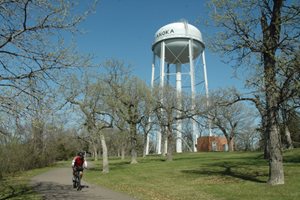All communities that have public water supplies in the Twin Cities Metropolitan Area are required to prepare water supply plans as part of their local comprehensive plan. Communities and utility boards must officially adopt the plan along with the local comprehensive plan.
Communities without public water supplies do not need to prepare a water supply plan, but should include information about plans to protect private water supplies in appropriate sections of the local comprehensive plan, described in the sections on conservation and reuse, source water protection, and sub-regional collaboration.

Minimum Requirements:

-
If the community has a municipal community public water supply system, complete all information in the DNR & Metropolitan Council water supply plan template. Information must be submitted in the template provided and submitted through the MnDNR Permit and Reporting System (MPARS).
-
Include extended water demand projections for 2020, 2030, 2040 and ultimate build-out that are consistent with population forecasts in the community’s system statement.

Get More Out of Your Plan:
As appropriate, incorporate the following into plans and programs, consistent with your organization's roles and responsibilities:
-
Acknowledge potential water supply issues identified in your community’s water supply profile (Appendix 1 of the Master Water Supply Plan) and support partnerships to address them in local water plans and water appropriation permit applications.
-
Explore and support water demand (water conservation and efficiency) programs such as incentives, ordinances, education and outreach, rates and other approaches, the metropolitan Council’s Water Conservation Toolbox can support these efforts.
-
As appropriate, support collaborative efforts to evaluate the likelihood of significant declines in aquifer water levels before water appropriation permits are requested. The analysis may be determined in consultation with DNR.
-
Work with partners to evaluate relationships between aquifer withdrawals and surface water features. If a connection is likely, management plans should include aquifer testing, monitoring water levels and pumping rates and surface water flow, triggers and actions to protect aquifer levels, a schedule for periodic analysis of data to identify the need for action to mitigate impacts, and a schedule for periodic and timely reporting to DNR.
-
Collaborate with partners, including MDH and others, to support local actions that prevent spread of contamination.
-
Work with partners to identify opportunities for sharing information, reducing duplicate work, and partnering on projects that improve understanding about aquifer productivity and extent.
-
If a Groundwater Management Area has been designated in your area, partner with DNR and neighboring water users to use water in accordance with the approved plan.
-
Support collaborative efforts to periodically review local water supply risks and potential alternatives to mitigate those risks. Technical advances, regulatory adjustments and subregional developments can present new opportunities for local water suppliers to enhance the resiliency, sustainability, and affordability of their water suppliers.
-
Continue to work with local, state and federal agencies, as required.

We Can Help!